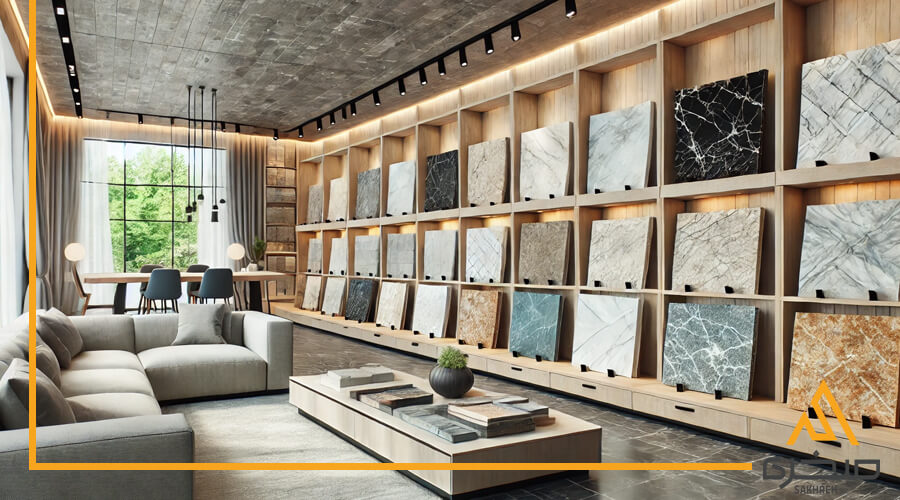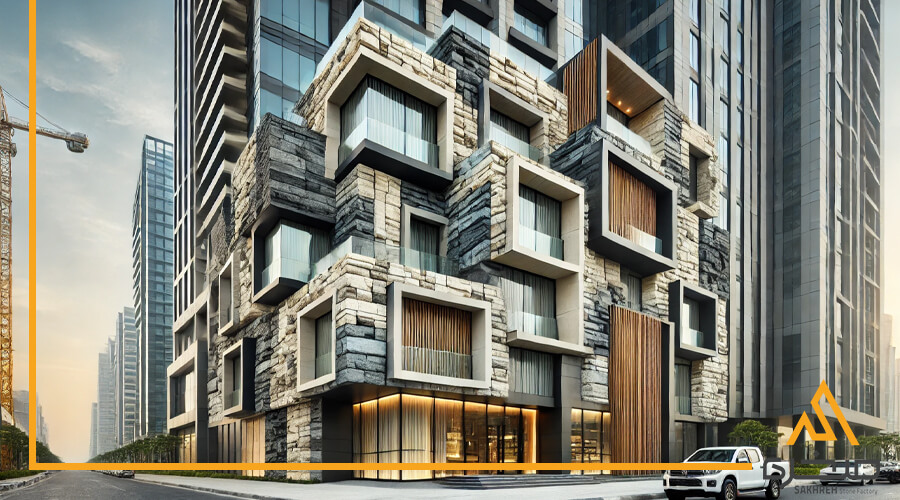Articles
Stones have long been one of the most popular and attractive materials used in interior home decoration. This natural material, due to its unique beauty, high durability, and variety of colors and patterns, has always been an exceptional choice for interior designers and homeowners. In the following, we will examine the types of stones used in interior decoration and their diverse applications.
If you intend to purchase diverse and high-quality building stones, Sakhreh Stone can be considered one of the top options for selecting and acquiring various types of building stones.
Types of Stones for Interior Decoration
Explore the diverse types of stones for interior decoration, each offering unique aesthetics and functionality. From luxurious marble to modern basalt, find the perfect match to enhance your living space with style and durability.
1. Quartzite: Strength and Beauty Combined
Quartzite is a natural stone that resembles marble but offers greater durability. Available in colors like white, gray, pink, and blue, it is commonly used in kitchens, bathrooms, and decorative walls.
With its high resistance to wear and tear and stunning patterns, quartzite can serve as a focal point in interior design. For example, a decorative quartzite wall in a living room can elevate the overall aesthetic.
2. Basalt: Modern and Industrial
With its dark colors and matte finish, basalt is a favored material in industrial and modern interior designs. It is highly resistant to impact and heat, making it suitable for flooring, walls, and even kitchen countertops.
Basalt conveys a sense of modernity and strength, making it an excellent choice for minimalist homes or industrial-style interiors.
3. Marble: A Symbol of Elegance and Beauty
Marble is one of the most popular stones for interior decoration, renowned for its striking appearance and natural shine that creates a luxurious and inviting atmosphere. Found in colors like white, cream, green, black, and pink, its natural veins add a unique charm to any space. Marble is ideal for flooring, walls, fireplaces, and even kitchen countertops. However, it requires proper maintenance as it is sensitive to stains and acids.
Marble also provides a cooling sensation, making it ideal for warm climates. It is commonly used in formal and luxurious spaces such as living rooms or grand entrances to enhance the elegance of the area.
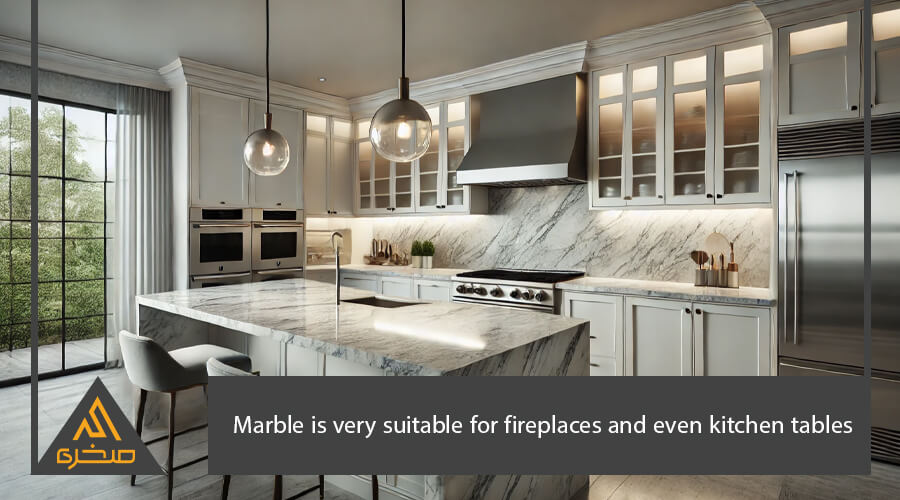
4.limestobe
Limestone, with its simple appearance and light colors, is perfect for minimalist and modern interior styles. Often used for flooring and walls, it adds a sense of calmness and softness to any space due to its smoother texture compared to other stones.
Limestone’s ability to create a natural and organic ambiance makes it particularly suitable for small spaces like bathrooms or compact kitchens, helping them appear larger and brighter.
5. Antique Stone: Artistic and Unique
Antique stones, crafted from small pieces of natural stones, are ideal for decorating walls, frames, and columns.
These stones are perfect for homeowners seeking a blend of art and nature. For example, an antique stone wall in the dining area can transform the space into an artistic gallery-like environment.
6. Granite: Durable and Versatile
Granite is one of the hardest and most durable natural stones, making it an excellent choice for high-traffic areas like kitchens and bathrooms. Resistant to scratches and heat, granite comes in various colors such as white, gray, brown, and black. Its granular texture adds depth and character to interior spaces.
Granite is also highly polished, resulting in a shiny and reflective surface. This feature makes it popular not only for practical uses but also for decorative purposes.

7. Travertine: A Classic and Warm Choice
Travertine is one of the oldest building materials, valued for its natural appearance and porous texture that exudes warmth and coziness. Available in natural shades like cream, brown, gold, and gray, it is commonly used for flooring, interior walls, and bathroom finishes.
The porous nature of travertine also provides sound absorption, making it ideal for busy and noisy areas such as living rooms or playrooms. Additionally, it is widely used in outdoor spaces like terraces or courtyards.
8. Sandstone: Natural and Soothing
Sandstone, with its warm colors and distinctive texture, brings a natural and calming feel to interior spaces. It is often used for walls, fireplaces, and relaxation areas.
One of sandstone’s standout features is its ability to blend seamlessly with other natural materials like wood and glass, creating a harmonious and tranquil ambiance.

Choosing the Right Stone Based on Space Needs
Selecting the right stone for interior decoration depends on the specific needs and features of each space. Different areas of the home have unique requirements that should be considered when choosing materials. Below are the recommended stones for three key areas: the kitchen, bathroom, and living room.
1. Kitchen
The kitchen is a high-traffic area that requires durable materials resistant to heat, stains, and scratches. Granite and quartzite are excellent choices:
- Granite: Its high hardness and resistance to heat and scratches make it an outstanding option for kitchen countertops. Granite is also resistant to food or liquid stains and comes in various colors like white, black, and gray, adding natural beauty to the space.
- Quartzite: A stunning and durable alternative to marble, quartzite offers luxurious aesthetics with natural veining while resisting scratches and stains, enhancing the kitchen’s elegance.
2. Bathroom
Bathrooms, being constantly exposed to moisture, require stones that are not only beautiful but also water-resistant. Travertine and glass stone are ideal for this space:
- Travertine: With its porous texture and warm colors, travertine creates a natural and relaxing ambiance in bathrooms. It is particularly suitable for walls and flooring but should be treated with waterproof coatings for added durability.
- Glass Stone: Reflecting light and adding brightness, glass stones are perfect for small bathrooms, making them appear more spacious while delivering a modern look.
3. Living Room
The living room is a central part of the home, playing a significant role in showcasing the beauty and overall style of interior decoration. Marble and sandstone are top choices for this space:
- Marble: For a luxurious and formal ambiance, marble is unmatched. Its glossy finish and natural veining bring grandeur and elegance to the living room, making it ideal for flooring or decorative walls.
- Sandstone: For a natural and calming atmosphere, sandstone is perfect. Its warm texture and natural tones add a cozy and inviting feel to the living room, often used for accent walls or fireplaces.
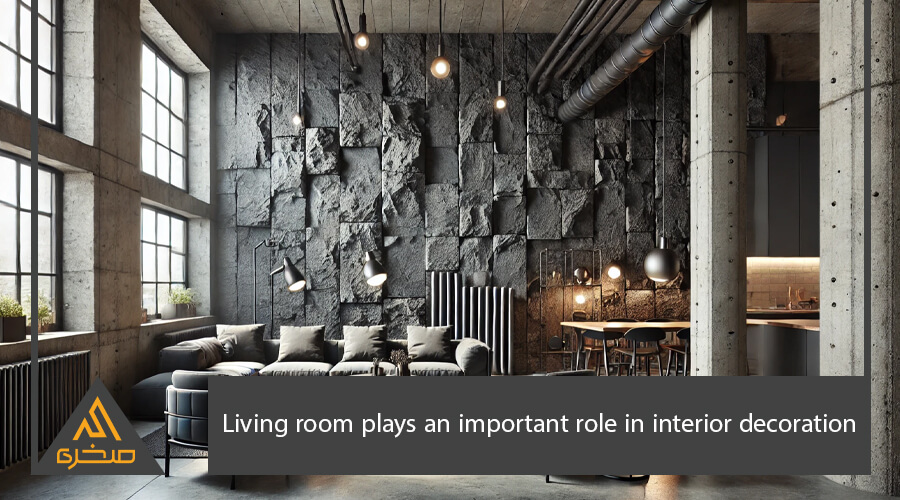
Conclusion
In this article from the Sakhreh blog, we discussed the importance of choosing the right stone for interior decoration and examined key considerations in this area. The correct selection of stone can have a significant impact on the beauty, durability, and harmony of an interior space. By considering factors such as design style, type of stone, and budget, you can choose the best option for your space.
Building stones are among the most commonly used materials in construction, valued for their beauty, durability, and unique properties, making them ideal for various architectural projects. Each type of stone has specific advantages and disadvantages based on its characteristics and properties, which must be considered. In this article, we provide a comprehensive review of the features and applications of different building stones, including granite, limestone, marble, scratch stone, travertine, antique stone, gabbro, and quartz, along with tables comparing the pros and cons of each type. If you are looking to purchase high-quality and diverse building stones, Sakhreh Stone is one of the best options for selecting and buying various types of building stones.
1. Granite
Granite is one of the most popular building stones worldwide, known for its hardness and high durability. This igneous stone forms through the slow cooling of magma beneath the Earth’s surface.
Features
- High resistance to pressure and scratches: Ideal for high-traffic areas or outdoor environments.
- Water resistance: Due to its dense structure, granite absorbs minimal water, making it suitable for moist environments.
- Heat and chemical resistance: It withstands direct heat and exposure to strong chemicals.
- Natural beauty and color variety: The fine crystal patterns give granite a unique aesthetic appeal.
Applications
- Interior flooring and wall cladding: Durable and aesthetically pleasing for luxury designs.
- Kitchen countertops: Scratch and stain-resistant, making it perfect for kitchen surfaces.
- Outdoor paving: Suitable for weather-resistant pathways and high-pressure areas.
- Columns and staircases: Often used in modern and upscale projects.
| Advantages | Disadvantages |
|---|---|
| High scratch and impact resistance | Heavyweight, complicating installation |
| Long lifespan | High extraction and installation costs |
| Moisture and chemical resistance | Requires specialized cutting and installation |
| Variety in colors and patterns | Limited customization options |

2. Limestone
Limestone, also known as calcium carbonate, is a sedimentary stone widely used in construction due to its softer texture and neutral tones.
Features
- Soft and easy to process: Ideal for creating intricate designs.
- Subtle, natural colors: Ranging from white and cream to gray, adding calmness to interiors.
- High porosity: Requires waterproof coatings in humid environments.
- Lightweight compared to other stones: Easier to install than granite or marble.
Applications
- Building facades: Popular for modern and natural appearances.
- Interior design: Flooring and wall cladding in low-moisture areas.
- Sculptures and decor: High processability makes it suitable for artistic purposes.
| Advantages | Disadvantages |
|---|---|
| Lightweight and easy installation | High water absorption and vulnerability to moisture |
| Simple processing for custom designs | Less durable than harder stones |
| Cost-effective | Requires regular maintenance and coatings |
| Elegant natural colors | Sensitive to weather changes |
3. Marble
Marble is considered a luxurious stone, admired for its unmatched beauty and unique texture. It is formed through the metamorphosis of limestone under heat and pressure.
Features
- Natural sheen: Its polished surface gives a sophisticated look to interiors.
- Pressure resistance: Suitable for flooring and weight-bearing surfaces.
- Wide color variety: Available in shades like white, green, black, and pink.
- Susceptibility to acids and scratches: Can be damaged by acidic substances or sharp objects.
Applications
- Interior flooring and wall cladding: Especially in luxury spaces like hotels and halls.
- Countertops: Ideal for premium kitchen designs.
- Artwork and sculptures: Highly processable and polishable for artistic works.
| Advantages | Disadvantages |
|---|---|
| Luxurious appearance with natural gloss | High sensitivity to acids |
| Unique designs for creative use | Expensive |
| Extensive color options | Requires continuous care |
| Moderate pressure resistance | Prone to scratching |

4. Scratch Stone
Scratch stone is a modern and distinctive building material often used for creating unique and attractive designs.
Features
- Modern look with textured grooves: Ideal for contemporary and creative designs.
- Scratch resistance: Suitable for exterior cladding.
- Weather resistance: Perfect for harsh environmental conditions.
Applications
- Modern facades: Used in contemporary projects.
- Interior decorative walls: Adds character to unique designs.
- Column cladding: Provides a standout appearance.
| Advantages | Disadvantages |
|---|---|
| Unique and distinctive appearance | High design and installation costs |
| Resistant to weather conditions | Limited color variety |
| Durable | Challenging to process and cut |
| Suitable for exterior use | Expensive to repair |
5. Travertine
Travertine is a popular sedimentary stone, appreciated for its variety of colors and natural patterns.
Features
- Lightweight with high adhesion: Easily bonds to mortar and is lighter than granite.
- Warm, natural colors: Available in cream, gold, and brown hues.
- Porosity: Provides a natural appearance but requires maintenance.
- Sound and heat insulation: Ideal for residential buildings.
Applications
- Building facades: Lightweight and adhesive.
- Garden pathways: Adds natural beauty to landscapes.
- Pools and moist areas: Durable in wet environments.
| Advantages | Disadvantages |
|---|---|
| Lightweight and easy installation | Requires regular maintenance |
| Natural and beautiful appearance | High water absorption |
| Sound and heat insulation | Sensitive to chemicals |
| Affordable | Less durable than granite or marble |

6. Antique Stone
Antique stone, a composite of natural and artificial elements, is valued for its decorative and aesthetic appeal.
Features
- Decorative and elegant: Used in both interior and exterior designs.
- Durable: Resistant to wear and environmental changes.
- Versatile in designs and colors: Can blend with various construction materials.
Applications
- Interior decorative walls: Suitable for both modern and classical spaces.
- Building facades: Adds uniqueness to exterior designs.
- Fireplaces and columns: Enhances decorative elements.
| Advantages | Disadvantages |
|---|---|
| Attractive appearance | High design costs |
| Durable | Difficult to install and maintain |
| High versatility | Limited structural applications |
| Relatively lightweight | Susceptible to harsh weather |
7. Gabbro
Gabbro is an igneous stone known for its durability and strength, making it ideal for heavy-duty applications.
Features
- Dark colors and dense texture: Usually in black, gray, or dark green tones.
- High pressure and abrasion resistance: Suitable for high-traffic areas.
- Water resistance: Absorbs minimal water due to its dense structure.
- Weather durability: Ideal for extreme temperature variations.
Applications
- Road and pathway paving: High abrasion resistance for heavy use.
- Bridges and tunnels: Used in large construction projects.
- Modern facades: Provides a sleek and minimalist appearance.
- Industrial flooring: Ideal for factory settings due to its strength.
| Advantages | Disadvantages |
|---|---|
| High resistance to pressure | Heavy, complicating transport and installation |
| Long-lasting durability | Limited color variety |
| Moisture-resistant | Expensive extraction and processing |
| Suitable for high-traffic areas | Limited decorative use |
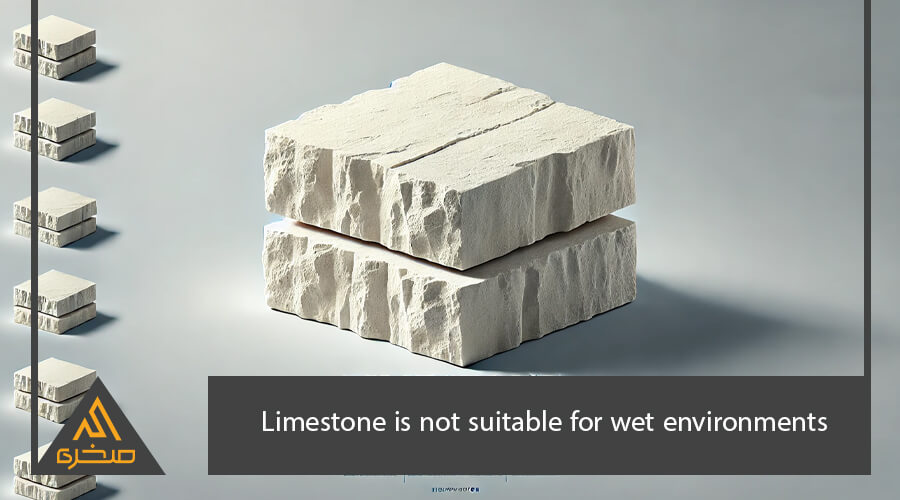
8. Quartz
Quartz is an engineered stone made by combining natural materials with resin. It is known for its aesthetic and functional qualities.
Features
- Polished and shiny surface: Creates a modern and sleek look.
- Non-porous structure: Stain and water-resistant.
- High scratch and impact resistance: Among the most durable artificial stones.
- Wide range of colors and designs: Suitable for various preferences and spaces.
- Low maintenance: Unlike natural stones like marble, quartz requires minimal upkeep.
Applications
- Kitchen countertops: Resistant to stains and acids.
- Interior wall cladding: Especially for modern spaces.
- Tables and work surfaces: Ideal for offices and luxury environments.
- Bathrooms: Resistant to moisture, making it perfect for wet areas.
| Advantages | Disadvantages |
|---|---|
| Water and stain resistance | High production costs |
| Variety in colors and designs | Artificial appearance may not suit some projects |
| Scratch and impact resistance | Sensitive to high heat |
| Low maintenance | Relatively heavy |
Conclusion
In this article from the Sakhreh blog, we explored how building stones, due to their high diversity, durability, and beauty, are among the primary choices for architectural and construction projects. Each stone, such as durable granite, marble, and travertine, has unique characteristics that make it suitable for specific applications. An informed selection of stone can have a significant impact on the longevity and appeal of a project.
Building stones are among the most important and widely used materials in construction, significantly impacting the durability and aesthetics of structures. Choosing the right stone can enhance not only the lifespan of a building but also its visual appeal. However, selecting and purchasing building stones requires knowledge and careful consideration. This article delves into the essential factors to keep in mind when selecting and buying building stones.
If you intend to purchase high-quality building stones, Sakhreh Stone can be one of the top choices for supplying various types of building stones.
Types of Building Stones
Due to their vast variety, building stones are used in diverse applications. Here are some of the most common types:
- Travertine: A porous and attractive stone known for its strong adhesion, ideal for facades and walls.
- Granite: The most durable stone, commonly used in flooring and kitchen countertops.
- Marble: A luxurious stone with a glossy appearance, perfect for elegant spaces.
- Sandstone: Features a natural texture and aesthetic, suitable for interior and exterior designs.
- Crystal (Chinese Stone): Smooth and resilient, ideal for humid areas.
- Basalt: A dark and robust stone often used in industrial designs.
- Antique Stone: Small pieces of natural stones used for decorative purposes.
Factors to Consider When Choosing Building Stones
To choose the right stone, several key factors should be considered:
- Climate Conditions: In colder regions, stones like travertine and granite, which are resistant to freezing, are more suitable.
- Application Location: Facade stones should be lightweight and durable, while flooring stones need to withstand wear and scratches.
- Budget: Natural stones like marble are more expensive, while travertine or sandstone are more budget-friendly options.
- Architectural Style: The stone’s design should align with the overall architectural style. For modern designs, simple and dark stones are more appropriate, whereas textured and natural-colored stones suit classical styles.

Important Tips for Buying Building Stones
Purchasing building stones directly influences the durability, aesthetics, and functionality of a building. Below are key tips for making a smart choice:
1. Assess Stone Quality
- Uniform Color and Texture: The stone should have consistent color and texture, with natural and appealing veins or lines.
- Absence of Cracks and Gaps: Inspect closely for cracks or visible gaps, as they can reduce the stone’s durability.
- Resistance to Impact and Pressure: Durable stones like granite or travertine are better for high-traffic areas.
2. Match the Stone to Its Purpose
- For building facades, choose lightweight and moisture-resistant stones like travertine.
- For flooring, opt for scratch- and wear-resistant stones like granite or crystal stone.
- For interior walls, select aesthetically pleasing and lighter stones such as marble or sandstone.
3. Consider Climate Conditions
- Freeze-resistant stones like granite and travertine are suitable for cold regions.
- In humid areas, use stones with low water absorption, such as crystal stone or basalt.
4. Evaluate Costs and Budget
- Luxurious stones like marble are more expensive, while travertine is a cost-effective option.
- Focus on the balance between price and quality, ensuring the stone meets your budget without compromising aesthetics.
5. Choose a Reputable Seller
- Buy from reputable stores or manufacturers to ensure product authenticity and quality.
- Opt for sellers who offer quality guarantees.
6. Review Installed Samples
- Before purchasing, examine samples of the stone installed in real settings to assess its performance.
- Ensure the stone complements your architectural vision after installation.
7. Factor in Transportation and Installation
- Heavier stones like granite may incur higher transportation costs.
- Professional installation is crucial, as improper methods can lead to cracking or detachment.
8. Strengthen the Stone Before Installation
- Some stones, like travertine, may require waterproofing or protective coatings.
- Use sealants to prevent water and stains from penetrating the stone’s surface.
9. Align the Stone with the Architectural Style
- Match the stone to the overall design, e.g.:
- Light and simple stones for modern styles.
- Textured and natural stones for classical designs.
10. Compare Prices
- Stone prices can vary in the market. Compare options to find the best balance of quality and cost.
- Consider additional expenses like transportation and installation when calculating the total cost.

Common Mistakes in Choosing Building Stones
Selecting the right building stone plays a vital role in the durability, aesthetics, and functionality of construction projects. However, mistakes in the selection process can lead to increased costs, reduced quality, and early repairs. Below are some common pitfalls to avoid:
1. Ignoring Climate Conditions
Using high-absorption stones like sandstone in humid or cold areas can result in freezing, cracking, and damage. Similarly, in tropical regions, stones that lack heat and UV resistance may discolor or degrade.
2. Using Inappropriate Stones for Specific Applications
- Using soft stones like marble in high-traffic flooring can lead to scratches and reduced longevity.
- Heavy stones like granite may not be suitable for facades due to added structural weight.
3. Focusing Solely on Appearance
While aesthetics are important, prioritizing appearance over quality and durability can lead to issues. A visually appealing stone with insufficient durability may require replacement or repair within a short period.
4. Buying from Unreliable Sellers
Purchasing stones from unverified sources may result in receiving low-quality, cracked, or non-genuine materials. Untrustworthy sellers may also lack guarantees for quality and durability.
5. Skipping Quality Inspections
Failing to inspect the stone’s quality and characteristics can lead to purchasing stones with cracks, holes, or uneven colors. Always check for uniformity, absence of cracks, and resistance to impact before buying.
6. Overlooking Additional Costs
Ignoring expenses such as transportation, installation, and maintenance can inflate overall project costs. For instance, heavier stones like granite require specialized handling and installation.
7. Using Unprofessional Installers
Even the best stone may lose its value due to poor installation. Non-expert installers can cause improper placement, breakage, or reduced stability of the stone.
8. Neglecting Post-Installation Care
Failure to properly maintain stones, especially natural ones like marble or travertine, can lead to stains, dullness, or damage. Regular cleaning and protective coatings are essential.
Conclusion
In this article from the Sakhreh blog, we discuss the importance of choosing the right building stone and the key factors to consider when purchasing it. Selecting the appropriate building stone can have a significant impact on the durability, beauty, and functionality of your construction project. On the other hand, mistakes such as choosing the wrong stone based on climate conditions or the place of use, focusing solely on appearance without considering quality, and working with unprofessional sellers or installers, can lead to numerous problems and additional costs.
The facade is one of the most essential aspects of a building’s design, not only influencing its aesthetic appeal but also protecting it from environmental factors. Stone is a popular choice for building facades due to its durability, natural beauty, and adaptability to various architectural styles. This article explores the types of stones used in building facades, their features, and applications.
If you are looking to purchase high-quality and diverse building stones, Sakhreh Stone is one of the best options for selecting and buying various types of building stones.
Factors Influencing the Choice of Facade Stones
Selecting the right stone for a building facade depends on several crucial factors:
- Climate Conditions: In regions with heavy rainfall or extreme cold, stones with high resistance to moisture and freezing are essential.
- Architectural Style: For modern designs, simple and minimalistic stones are preferred, whereas textured and natural stones are ideal for classical designs.
- Budget: Stones vary significantly in cost. The chosen stone must align with the available budget.
Types of Stones for Building Facades
1. Travertine
Travertine is one of the most widely used stones for building facades. Its porous texture and warm natural colors add a sense of intimacy and elegance to structures. Travertine’s resistance to temperature changes and strong adhesion make it suitable for areas with variable weather conditions. Additionally, it is versatile for various architectural styles.
2. Granite
Granite is one of the most durable and resilient facade stones. Its high hardness makes it resistant to scratches, heat, and moisture. The granular texture and wide color range make it a popular choice for modern buildings. However, its heavy weight may complicate installation.
3. Marble
Marble is a luxurious choice for facades, known for its natural shine and elegance. Available in diverse colors like white, cream, green, and black, marble adds a unique charm to buildings. However, it requires meticulous maintenance and may be vulnerable to harsh environmental conditions.
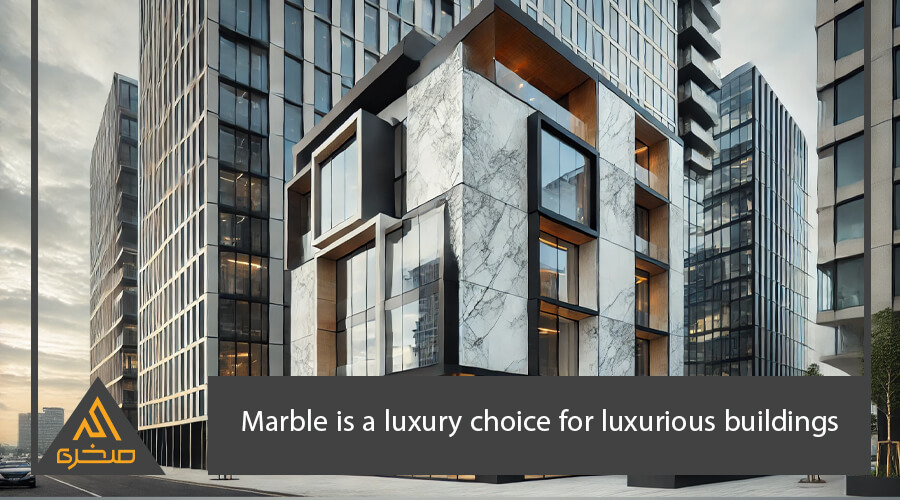
4. Sandstone
Sandstone is a natural stone with unique textures and colors, making it ideal for creative and distinctive facades. It is easy to cut and shape, making it suitable for both interior and exterior villa designs. However, it requires additional protection against moisture.
5. Crystal (Chinese Stone)
Crystal stone, also known as Chinese stone, is a natural material with a smooth surface and light colors. Its high resistance to environmental factors makes it suitable for regions with heavy rainfall and harsh weather conditions. Its smooth finish and bright appearance are ideal for modern facades.
6. Basalt
Basalt is a volcanic stone with a dark and matte appearance, often used in industrial and modern designs. Its high resistance to impact and environmental stress, along with its neutral color, allows it to blend well with other architectural elements.
7. Antique Stone
Antique stone is made from small pieces of natural stones and is used for decorative facades. Its artistic and unique designs make it more common in classical or rustic-style buildings.

Comparison of Facade Stones
| Features | Travertine | Granite | Marble | Sandstone | Crystal Stone | Basalt | Antique Stone |
|---|---|---|---|---|---|---|---|
| Durability | Moderate, freeze-resistant | Very high resistance to scratches and heat | Moderate, sensitive to harsh conditions | Moderate, sensitive to moisture | High resistance to environmental factors | Very high resistance to impact and stress | Moderate, suitable for decorative use |
| Aesthetics | Warm natural colors | Granular and modern | Glossy and luxurious with natural veins | Unique texture and natural look | Smooth surface and light colors | Matte and dark, ideal for industrial designs | Artistic and unique, classic appeal |
| Cost | Affordable | Relatively high | Expensive | Affordable | Moderate | Moderate to high | Variable depending on design |
| Maintenance | Easy, may require waterproofing | Easy | Requires regular care | Needs protection from moisture | Easy | Easy | Requires attention to installation and cleaning |
| Applications | Exterior facades, interior walls | Modern facades, high-traffic areas | Luxurious buildings | Creative villas | Modern facades, rainy regions | Industrial and modern designs | Decorative interior and exterior facades |
Ideas for Combining Stones in Facade Design
Combining multiple types of stones in a building facade is a creative approach to achieving a unique and eye-catching appearance. This method allows designers to play with colors, textures, and patterns to create stunning and distinctive structures. Blending stones can work in modern, classical, or even industrial styles, giving the building a specific identity.
– Travertine and Granite Combination
Using warm-colored travertine for the main facade and dark granite for framing doors and windows creates a striking contrast, suitable for classical and formal buildings.

– Marble and Basalt Combination
White or cream marble can be used for prominent facade features like columns, while dark basalt serves as a backdrop. This blend is ideal for creating a luxurious and modern appearance.
– Antique Stone for Decorative Elements
Adding antique stone to simple facades made of sandstone or travertine can create an artistic and unique look, especially for trims or engravings.
– Contrasting Colors
Pairing light stones like crystal stone with dark ones like granite or basalt creates visual contrast, resulting in a dynamic and eye-catching facade.
– Natural and Artificial Stone Mix
Using natural stones for main sections and artificial stones for decorative details not only reduces costs but also enables more intricate designs.
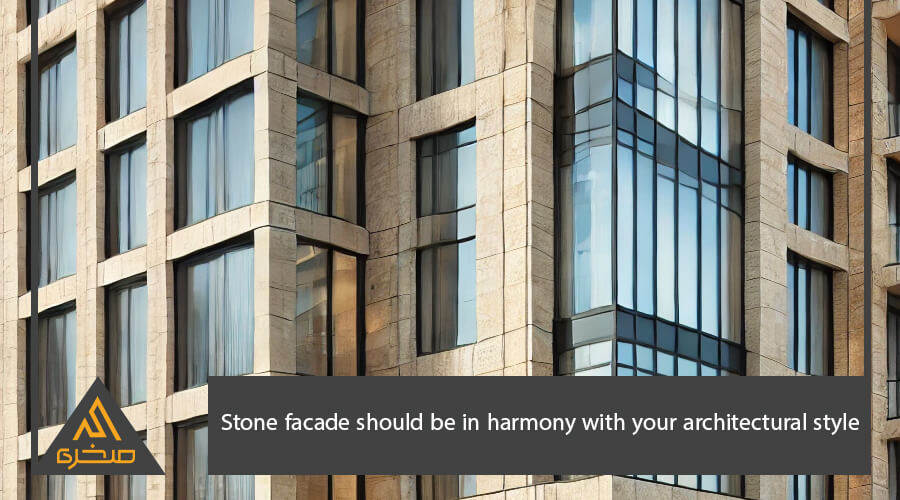
conclusion
In this article from the Sakhreh blog, we explored how building stones, due to their high diversity, durability, and beauty, are among the primary choices in architectural and construction projects. Each stone, such as durable granite, marble, and travertine, has unique characteristics that make it suitable for specific applications. An informed selection of stone can have a significant impact on the longevity and appeal of a project.


